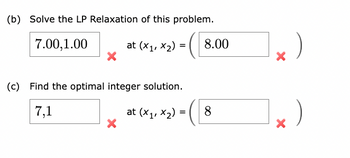(a) Graph the constraints for this problem. Use dots to indicate all feasible integer solutions. X₂ X₂ 8 6 6 (b) Solve the LP Relaxation of this problem. at (x₁, x₂) = (c) Find the optimal integer solution. at (x₁, x₂) = 8 4 6 8 DO X₂ DO 8 6 8 G
(a) Graph the constraints for this problem. Use dots to indicate all feasible integer solutions. X₂ X₂ 8 6 6 (b) Solve the LP Relaxation of this problem. at (x₁, x₂) = (c) Find the optimal integer solution. at (x₁, x₂) = 8 4 6 8 DO X₂ DO 8 6 8 G
Practical Management Science
6th Edition
ISBN:9781337406659
Author:WINSTON, Wayne L.
Publisher:WINSTON, Wayne L.
Chapter2: Introduction To Spreadsheet Modeling
Section: Chapter Questions
Problem 20P: Julie James is opening a lemonade stand. She believes the fixed cost per week of running the stand...
Related questions
Question
![### All-Integer Linear Program
Consider the following all-integer linear program:
**Objective:**
\[ \text{Maximize } 1x_1 + 1x_2 \]
**Subject to:**
1. \( 5x_1 + 6x_2 \leq 41 \)
2. \( 1x_1 + 7x_2 \leq 21 \)
3. \( 2x_1 + 1x_2 \leq 15 \)
**Constraints:**
\[ x_1, x_2 \geq 0 \text{ and integers} \]
---
### Task
#### (a) Graph the constraints for this problem.
Use dots to indicate all feasible integer solutions.
**Graphical Analysis:**
The problem involves three graphs, each showing the feasible region (in blue) for combinations of \( x_1 \) and \( x_2 \). Dots within the blue area represent feasible integer solutions that satisfy all constraints.
1. **First Graph:**
- **Axes:** \( x_1 \) (horizontal), \( x_2 \) (vertical)
- **Feasible Region:** The bounded polygon indicates possible values for \( x_1 \) and \( x_2 \) satisfying the constraints.
2. **Second Graph:**
- Same axes setup as the first graph, depicting the same feasible region.
3. **Third Graph:**
- Same axes setup and depiction, reiterating the feasible region with integer solutions marked by dots.
#### (b) Solve the LP Relaxation of this problem.
\[ \text{Optimal Solution at } (x_1, x_2) = \left( \boxed{\phantom{00}} \right) \]
#### (c) Find the optimal integer solution.
\[ \text{Optimal Integer Solution at } (x_1, x_2) = \left( \boxed{\phantom{00}} \right) \]
Each graph and solution box aids in determining the optimal solutions based on the constraints and objectives provided. To solve the relaxation or the integer problem, one would typically use methods such as the Simplex algorithm or integer programming techniques.](/v2/_next/image?url=https%3A%2F%2Fcontent.bartleby.com%2Fqna-images%2Fquestion%2Feeaa8045-e0ae-4f8f-bfb9-81e4f69114f4%2F786baac4-388a-4460-bcfc-f706411f0687%2F0mc435j_processed.png&w=3840&q=75)
Transcribed Image Text:### All-Integer Linear Program
Consider the following all-integer linear program:
**Objective:**
\[ \text{Maximize } 1x_1 + 1x_2 \]
**Subject to:**
1. \( 5x_1 + 6x_2 \leq 41 \)
2. \( 1x_1 + 7x_2 \leq 21 \)
3. \( 2x_1 + 1x_2 \leq 15 \)
**Constraints:**
\[ x_1, x_2 \geq 0 \text{ and integers} \]
---
### Task
#### (a) Graph the constraints for this problem.
Use dots to indicate all feasible integer solutions.
**Graphical Analysis:**
The problem involves three graphs, each showing the feasible region (in blue) for combinations of \( x_1 \) and \( x_2 \). Dots within the blue area represent feasible integer solutions that satisfy all constraints.
1. **First Graph:**
- **Axes:** \( x_1 \) (horizontal), \( x_2 \) (vertical)
- **Feasible Region:** The bounded polygon indicates possible values for \( x_1 \) and \( x_2 \) satisfying the constraints.
2. **Second Graph:**
- Same axes setup as the first graph, depicting the same feasible region.
3. **Third Graph:**
- Same axes setup and depiction, reiterating the feasible region with integer solutions marked by dots.
#### (b) Solve the LP Relaxation of this problem.
\[ \text{Optimal Solution at } (x_1, x_2) = \left( \boxed{\phantom{00}} \right) \]
#### (c) Find the optimal integer solution.
\[ \text{Optimal Integer Solution at } (x_1, x_2) = \left( \boxed{\phantom{00}} \right) \]
Each graph and solution box aids in determining the optimal solutions based on the constraints and objectives provided. To solve the relaxation or the integer problem, one would typically use methods such as the Simplex algorithm or integer programming techniques.
Expert Solution
This question has been solved!
Explore an expertly crafted, step-by-step solution for a thorough understanding of key concepts.
This is a popular solution!
Trending now
This is a popular solution!
Step by step
Solved in 3 steps with 3 images

Follow-up Questions
Read through expert solutions to related follow-up questions below.
Follow-up Question
I am not sure why these are incorrect

Transcribed Image Text:(b) Solve the LP Relaxation of this problem.
7.00,1.00
X
at (x1, x₂) =
(c) Find the optimal integer solution.
7,1
X
at (x₁, x₂) =
8.00
8
X
Solution
Recommended textbooks for you

Practical Management Science
Operations Management
ISBN:
9781337406659
Author:
WINSTON, Wayne L.
Publisher:
Cengage,

Operations Management
Operations Management
ISBN:
9781259667473
Author:
William J Stevenson
Publisher:
McGraw-Hill Education

Operations and Supply Chain Management (Mcgraw-hi…
Operations Management
ISBN:
9781259666100
Author:
F. Robert Jacobs, Richard B Chase
Publisher:
McGraw-Hill Education

Practical Management Science
Operations Management
ISBN:
9781337406659
Author:
WINSTON, Wayne L.
Publisher:
Cengage,

Operations Management
Operations Management
ISBN:
9781259667473
Author:
William J Stevenson
Publisher:
McGraw-Hill Education

Operations and Supply Chain Management (Mcgraw-hi…
Operations Management
ISBN:
9781259666100
Author:
F. Robert Jacobs, Richard B Chase
Publisher:
McGraw-Hill Education


Purchasing and Supply Chain Management
Operations Management
ISBN:
9781285869681
Author:
Robert M. Monczka, Robert B. Handfield, Larry C. Giunipero, James L. Patterson
Publisher:
Cengage Learning

Production and Operations Analysis, Seventh Editi…
Operations Management
ISBN:
9781478623069
Author:
Steven Nahmias, Tava Lennon Olsen
Publisher:
Waveland Press, Inc.